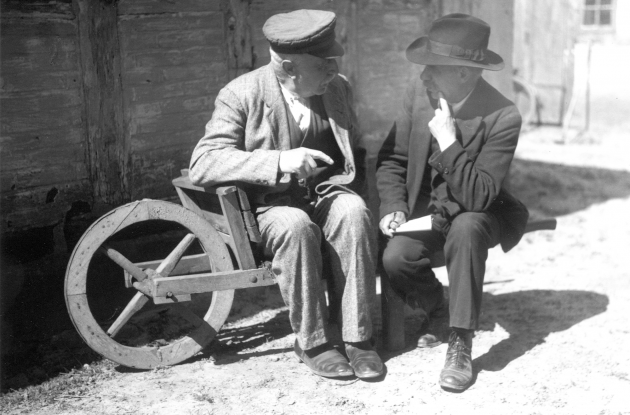How to find folklore and material about the culture of everyday life
Our archive of folklore tells the story of ordinary people’s lives and contains the folktales, songs and traditions we share as Danes.

Photo: Jørgen Jørgensen
Royal Danish Library's folklore collection is Denmark’s archive of folklore. We collect, preserve, explore and disseminate ordinary people's perceptions of life, memories, traditions, music and everyday stories.
The concept of folklore emerged in the 19th century as a term for the orally preserved traditions of people, but is used today primarily about the older material. Until the middle of the 20th century, we mainly focused on the culture of the rural population, but today the culture of all population groups is of interest, and we work with both historical and contemporary conditions.
Search and order
Most of our folklore and materials about the culture of everyday life are stored in our library vaults, but you can order them for use at the Research Reading Room in The Black Diamond. You can search for books, manuscripts and images in the library system. Expand the search field by selecting "search" in the top menu.
Once you have searched for a topic, title or keyword, you can select "Dansk Folkemindesamling" on the left side of the page under "Særsamlinger", if you want to narrow your search. You can also select the type of material if, for example, you only want to search for manuscripts.
We will send you an e-mail when the material is ready for you at the Research Reading Room.
Remember that you must always order the material before you show up at the reading room. You should also be aware that special rules apply to the use of the material in the reading room.
If you do not find what you are looking for, then write to Ask the library.
Search for books and magazines
You have to use the library system to search for our books and magazines on folklore and the culture of everyday life.
Our collection of textbooks on the culture of everyday life and folklore also contains a large collection of special prints, which in many cases are also registered in the library system.
The special editions are often only a few pages long and can be, for example, an article or a written lecture. You will see in the library system that the material is marked "special", but also that it says under the description that it is a special print. Similarly, many articles from journals have their own library item, so you can order a specific article that is part of a larger journal. They are marked with "art", and in the description is "article in ..."
All entries are provided with searchable keywords, just as it is possible to search for free text in all fields.
Some of our books are freely available for use in the reading room on the 5th floor in The Black Diamond, Copenhagen, while the rest must be ordered for use in the Research Reading Room.
Search for manuscripts
You must search and order the material as described above, and then you must be aware that the material must be ordered for review at the Research Reading Room in The Black Diamond, Copenhagen.
It can make it easier to search the manuscripts when you know the history of the folklore collection.
Search for images
You can search for the folklore archives' images in the library system, and you can view them at the Research Reading Room in The Black Diamond.
We also have digital images, which can only be seen by appointment in The Black Diamond, Copenhagen.
Not all images are available as positives, so it may be necessary to digitise the negative before you can see it. Under "format" you can see which formats the image is in.
If you want to buy a digital copy of an image, you also have the option to do so.
Be aware that there is also pictorial material in the part of the folklore collection that we call manuscripts.
You can find more photos in the collection of prints and photographs.
Search for audio and video
The folklore archive also includes audio and video. These are predominantly original recordings and to a lesser extent published material.
To find the desired audio recordings, you have to use our audio registrants.
The oldest recordings we have were recorded on wax cylinders in the period 1902-1947. Some of the oldest Danish recordings of folk songs and fiddler's music have been published under the title "Viser på valse" and are available on various streaming services or on The sound of Denmark.
You can find the titles at Forlaget Kragen.
Do a topographical search
If you are interested in a particular area, you can do a topographical search.
Non-circulatory material
The materials in the folklore collection are, as a general rule, available to everyone, but some material may be non-circulatory. That is, we cannot give everyone free access to it.
In some cases, a material will be non-circulatory because the person who gave us the material wants to restrict access to it. Other times, we deem it necessary to protect the material due to private circumstances.
The non-circulatory clause expires after a number of years, after which it is accessible.
How do you know if the material is non-circulatory?
If a material is non-circulatory, it is stated in the description when you order it. Write to us if you have questions about non-circulatory clauses and access to the collection or ask for an employee when you are at the Research Reading Room in The Black Diamond, Copenhagen.
Dispensation from non-circulatory clauses
In certain cases, we may make a dispensation for the clause for research purposes. Write to ask the library to find out more.